Graphically
| Site: | St. Louis |
| Course: | Michigan Algebra I Sept. 2012 |
| Book: | Graphically |
| Printed by: | Guest user |
| Date: | Sunday, November 30, 2025, 8:20 AM |
Description
Graphically
Finding Solutions
When a polynomial equation is set equal to 0, the solutions of the polynomial are the x-intercepts or roots of the corresponding graph. For example, to solve the equation, x4? x3 ? 19x2 ? 11x + 31 = 0 graphically, means to find the roots or x-intercepts of the corresponding function, f(x) = x4? x3 ? 19x2 ? 11x + 31. The graph below shows that there are 4 roots, at approximately x = -3, x = -2, x = 1, and x = 5. While these are not exact answers, they can be used to find exact answers using a table.
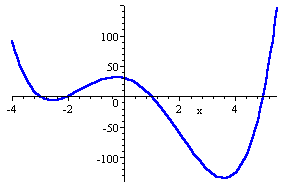
Example 1
-x3 + 5x2 - 3x - 3 = 0
Step 1. Create the corresponding function.
![]()
Step 2. Make a graph of the function.
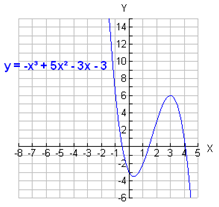
Step 3. Count the number of x-intercepts of the graph.
Example 2
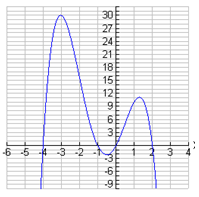
Step 1. Estimate the x-intercepts of the graph.
It appears that the zeros of the function are x = -4, x = -1, x = 0, and x = 2.
Step 2. Check the estimates by substituting into the equation.
![]()
Because the point is (-4, 0), x = -4 is an x-intercept, or zero, of the equation.
Check the remaining values to ensure accuracy.
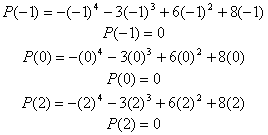
The zeros of the function are x = -4, x = -1, x = 0, and x = 2.
Example 3
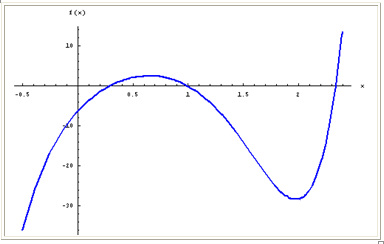
Step 1. Count the number of x-intercepts of the graph.
The graph has three x-intercepts.
Step 2. Make a statement about the comparison between the x-intercepts of the graph and the degree of the corresponding polynomial.
Since the number of x -intercepts is always equal to or less than the degree of the polynomial, this function is at least a third degree polynomial. However, it could also be a polynomial of any degree greater than three.
Interactive Activities
Cubic Polynomial Graphs
To learn more about the characteristics of polynomial graphs, select the following link:
Characteristics of Polynomial Graphs
Repeated Zeros
When solving polynomial equations, factoring may be used. If the factor (x ? r) occurs more than once in the factorization of a function, then r is called a repeated zero, or multiple zero.
For information about repeated zeros, select the following link:
Repeated Zeros
Practice
Answer Key
Sources
Analyze Math, "Cubing Functions." http://www.analyzemath.com/function/cubing_function.html (accessed 8/15/10).
Analyze Math, "Polynomial Functions." http://www.analyzemath.com/ function/ polynomial2/polynomial2.htm (accessed 8/15/10).
Embracing Mathematics, Assessment & Technology in High Schools; A Michigan Mathematics & Science Partnership Grant Project
Interactive Math, "Polynomial Functions and Equations." http://www.intmath.com/EqnsHiDe/1_Polynomials.php (accessed 8/13/10).
"Practice with Graphs." http://www.regentsprep.org/Regents/math/algtrig/ATE13/HighGraphsPractice.htm (accessed 8/15/10).
SOS Math, "Finding Roots." http://www.sosmath.com/algebra/factor/fac03a2/fac03a2.html (accessed 8/15/10).